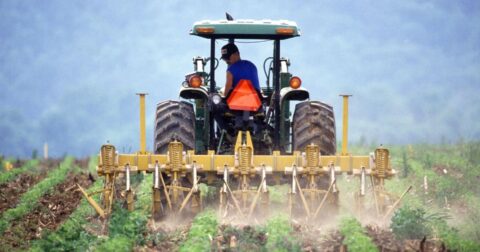Explainer
The Deep History of Racism and Speciesism Behind ‘They’re Eating the Dogs’
Election 2024•7 min read
Explainer
The farm bill is a collection of laws that governs our food system, including subsidies and federal nutrition benefits known as SNAP.


Words by Grace Hussain
The farm bill doesn’t always grab headlines. Yet twice per decade or so, this crucial piece of legislation sets the standard for our food system. The farm bill has an impact on what farmers grow and how they grow it, and it also dictates implementation of the SNAP food assistance program which benefits more than 41 million people every year.
The farm bill is an omnibus — a collection of various smaller pieces of legislation that are voted on once as a collective instead of individually — and it comes before Congress roughly every five years. It outlines support programs for farmers like subsidies, and handles a variety of other agricultural and agriculture-adjacent programs and measures.
The most recent farm bill was passed in 2018, known as the Agricultural Improvement Act. Hearings on the upcoming farm bill started during the second half of 2022 across the country, and have continued into the first several months of 2023 as Congress begins the process that will lead to the bill’s passage. Hearings are conducted by the Senate Congressional Committee on Agriculture, Nutrition and Forestry.
The farm bill, in simple terms, is a collection of proposed laws that all relate either directly or indirectly to agriculture. The bill provides a way for numerous smaller initiatives to be passed and enacted at one time, which can enable a larger coalition of support than exists for an individual policy. Common farm bill measures include subsidies, food assistance programs and conservation efforts.
The first farm bill was passed in the 1930s and since then 17 of them have been enacted by Congress. Called the Agricultural Adjustment Act of 1933, that first piece of legislation was passed as part of the New Deal. The bill provided relief to farmers who had been struggling due to both the Dust Bowl and the Great Depression. In exchange for reducing the amount of certain crops they were producing, farmers were paid by the government. Since then, subsidies have remained a core part of farm bills.
The first farm bill to be considered an omnibus bill was that of 1973, which expanded the focus of the bill to policy areas that impacted agriculture but were not solely about farms and farmers. Since the Agricultural and Consumer Protection Act of 1973, renewal of and changes to food assistance programs have been a part of the farm bill. The 1977 version made permanent changes to food stamp eligibility, while the 2008 farm bill renamed the food assistance program the Supplemental Nutrition Assistance Program (SNAP). In 2022, this program helped to feed 12 percent of the U.S. population.
Though the 1938 farm bill included incentives for farmers to use practices that conserved arable land, more explicit conservation measures were first seen in the 1977 Food and Agriculture Act, which added a section on rural development and conservation. The 1985 bill built on this with specific measures that incentivized preservation of wetlands and prevention of soil erosion. Since then, conservation has been a mainstay in each farm bill.
The process of creating the 2023 farm bill is well underway. Below are the steps that the bill will go through as it is written, discussed and eventually passed into law.
Two farm bills are written: one by the House and one by the Senate. These bills are the result of months of debates in committees and then on the chamber floors. The final farm bill that is signed into law by the president is a compromise between the two bills. The compromise bill is the result of a joint committee of both House and Senate members meeting to discuss the details of each bill. The result of that joint committee is then voted upon and passed by each chamber and presented to the president for their signature.
Each farm bill is broken up into different sections, called titles. Each section represents one policy area. The titles of the 2023 farm bill are likely to be similar to those that appeared in the 2018 version. The 2018 farm bill had 12 different titles:
The farm bill is a massive piece of legislation ultimately governed by the preferences, compromises and relationships of legislators and lobbyists representing hundreds of interest groups that all seek to have their voices heard. Though the process is extensive, the bill is not exhaustive. At the end of the process after each farm bill is passed, there are “winners” and “losers.”
In what was one of most controversial decisions in the 2018 farm bill, the legislation contained language that reduced the amount of SNAP benefits. The bill also cut the baseline of future funding for the Conservation Stewardship Program, which encourages farmers to consider the condition and quality of natural resources on their land.
As of the date of this article, the final budget for the 2023 farm bill has not been announced. However, projections suggest that the five-year cost of the bill will be $709 billion, and the 10-year cost to reach $1.4 trillion. These estimates are largely determined by the programs that the farm bill is required to fund based on current law. Food assistance accounts for the greatest portion of the farm bill, potentially accounting for 85 percent of the total for 2023, up from 76 percent from the 2018 legislation.
The farm bill is massive and complicated — yet the essential policies that govern our food system can be found within its pages. As the process of debating and enacting the 2023 farm bill gears up, pay close attention to the stakeholders and their demands. Many food system advocacy groups are closely tracking farm bill discussions — with events and newsletters to keep you informed of the latest developments.